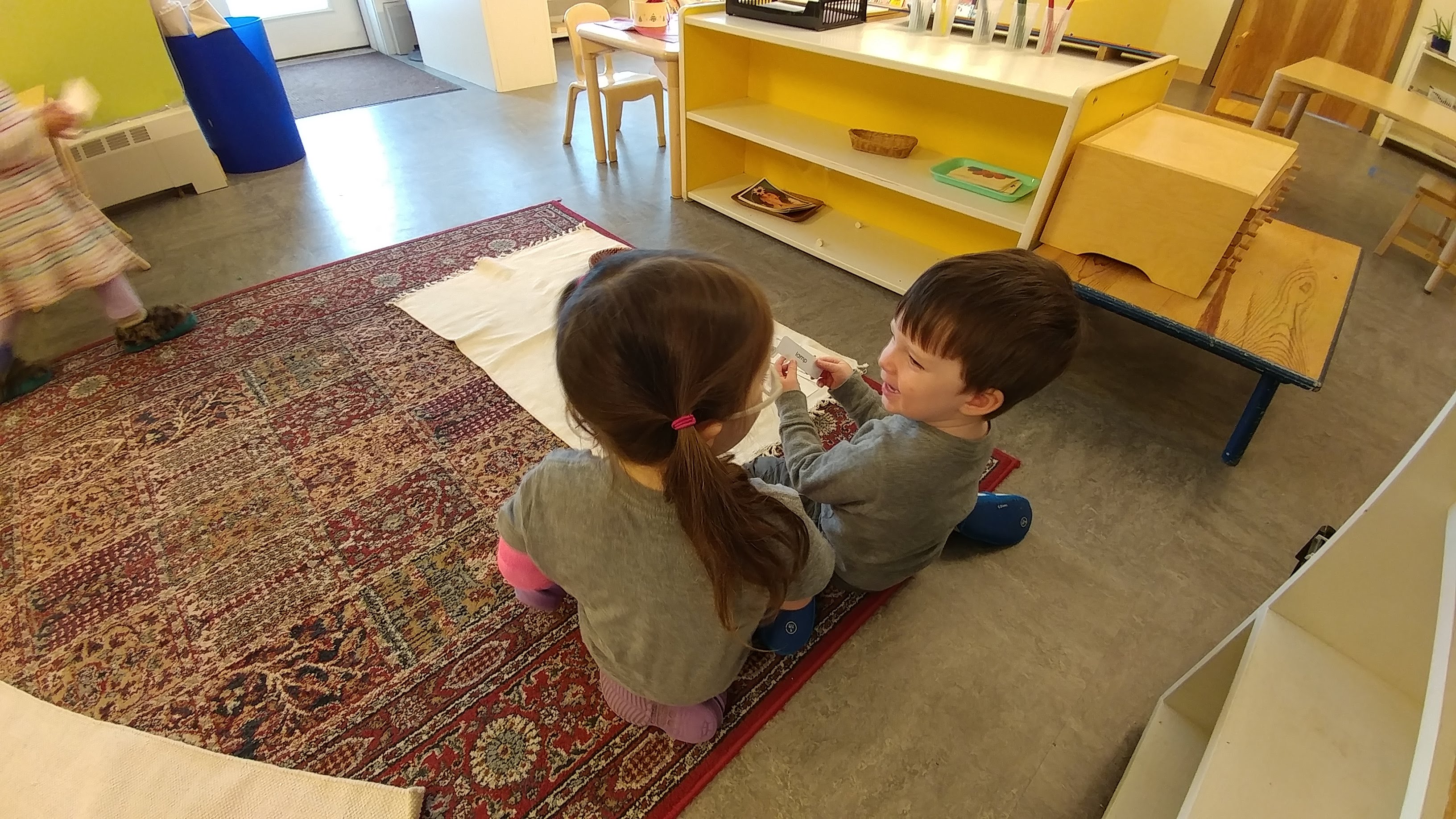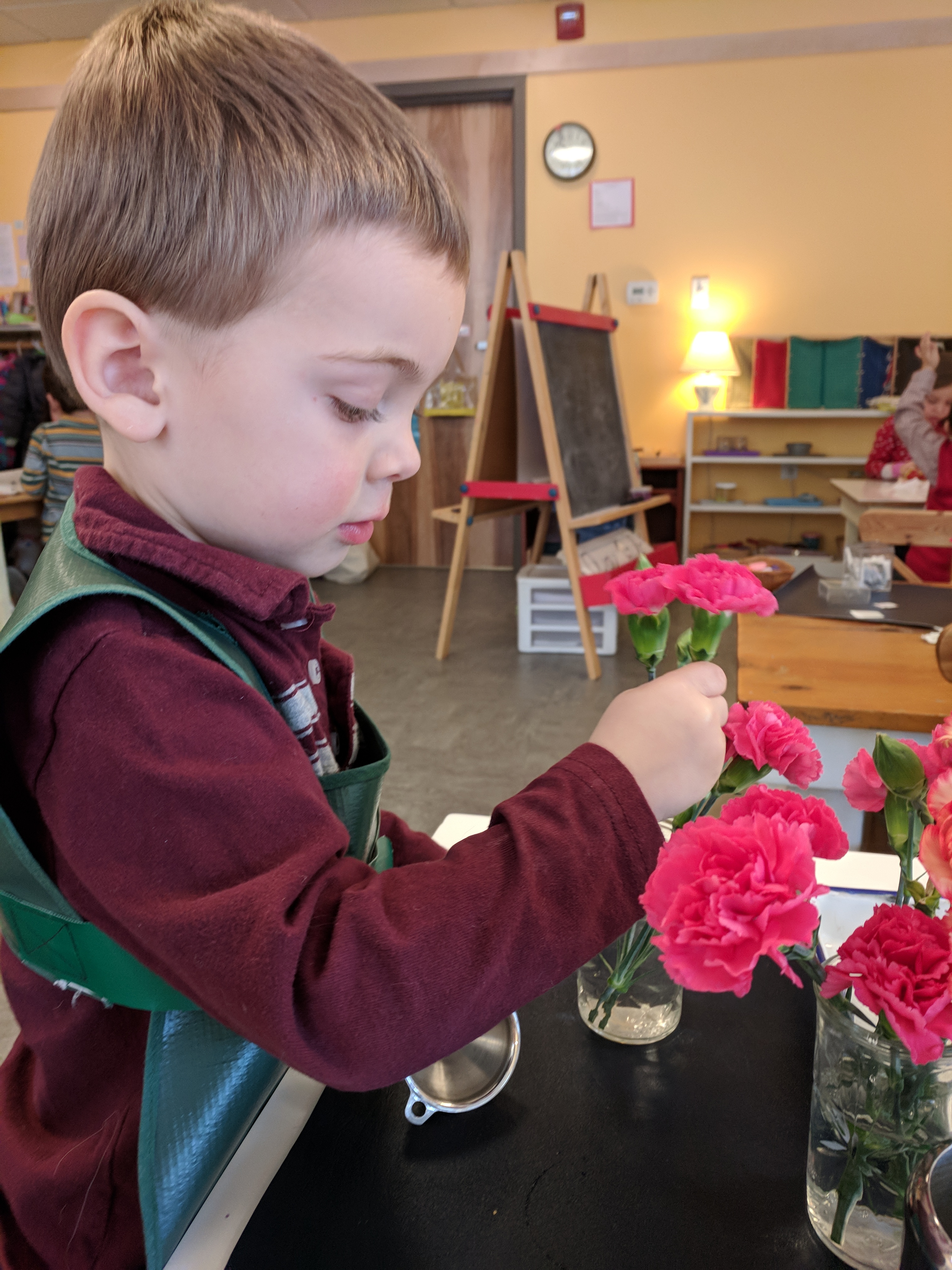
Notes from Hailey

Where has the time gone? It feels like January flew by with how busy the classroom has been lately! January brought us a new year and some new children to the classroom as well. With many of the children turning four this year, or about to turn four, they have taken on the roles of leaders, role models, and guides for the new, younger children. The four-year-olds are able to teach their younger friends how to be members of the classroom community by showing them how to get their snack, wash their dishes, or carry their work to a table, for example. On the other side of things, the 2.5 and 3-year-olds are teaching their older friends a lot about patience, kindness, and respect.
The return of very wintery weather has also given the children lots of practice with getting on and taking off their outdoor gear, as well as helping others when they may need an extra hand. The children are now starting to get into the habbit of getting their gear on by themselves, or at least trying their best, as well as asking a friend for help before asking Yoko or myself. It sometimes takes us a while to get ready and outside, but the children are so proud of themselves when they get ready without help.
Thank you to Paige Lamthi for our new hand towels - the colors have been a huge hit!
Notes from Emily
The Development of the Hand in the Primary aged Child
The skillful use of the hand to manipulate tools is arguably what sets humans apart from other animals, making possible the activity and inventions which have created human culture and continue to shape its evolution. Maria Montessori wrote beautifully in The Absorbent Mind that the hand and the mind are intricately related, that the hand is an instrument of the mind. The human hand is composed of 27 bones and is one of the most highly enervated parts of our body, making it extremely dexterous and highly sensitive to touch.
The primary aged child is driven by the urge to explore the world with their hands. How often have you as an adult become irritated by a young child because they just cannot stop touching everything? The hands are one of the sensors through which the young child explores the world and gathers data about the physical properties of their environment. The hands are also an outlet for the mind as the child develops personality, will, and self-discipline-- the mind wills the hands to act, and the child can observe the effects of their actions.
The primary classroom satisfies this developmental need by providing an environment designed to invite exploration and develop refined movement of the muscles of the hands. The classroom environment is beautiful and inviting, objects are placed within reach of the child, and a trained adult is present to demonstrate how to use these attractive objects and activities safely and effectively. Equally important is the culture of liberty for the children to explore and learn from their mistakes through their use of these objects with their hands. We provide the children with the opportunity to experience logical consequence in a safe environment.
Classroom activities of ‘Practical Life’ embody such attractiveness to the young child and are designed to strengthen and refine specific muscles of the hand and wrists. Practical life includes activities engaging the child’s control and coordination of gross motor movements so that the hands are free to work. Other Practical Life activities isolate particular skills including carrying a tray or pitcher, transferring objects with a spoon or tongs, pouring small grains and liquids, stringing large beads, using scissors or opening and closing containers with latches and screw top lids. These activities strengthen fine motor muscles and build hand-eye coordination. Activities of Practical Life reflect the daily tasks of life from the child’s culture and build in complexity as a child masters these preliminary movements. Activities include, but are not limited to, caring for their belongings, sweeping and mopping, preparing food for snack, hammering, arranging flowers, and embroidery. In addition to engaging and strengthening the child’s hands, these activities support functional independence and self-esteem for the child.
‘Sensorial’ activities offer another angle for engaging the child’s hand. In addition to satisfying the young child’s thirst for exploring and refining the five senses, many activities prepare the hand for writing. Many heavy blocks engage the muscles of the hand as the child carries them from the shelf to their work mat, and yet a child also needs to engage fine motor and hand-eye coordination skills to carefully stack the blocks. Some sensorial activities and games utilize knobs which encourage the child to use their ‘pincer grip,’ isolating the three fingers which will later hold a writing utensil. When using these activities, the adult observes use of the child’s dominant hand and encourages the child to use this prefered hand. Activities exploring the sense of touch enngage a tracing movement and lightness of touch which prepares the hand for later tracing sandpaper figures of numbers and letters. In addition to engaging with the direct purpose of learning to distinguish dimension, texture, or geometric form, these activities are also indirectly preparing the hands for writing. When a child is introduced to holding chalk or a pencil, they will have much more success because their hand is strong and coordinated.
With so many interesting and engaging activities offered to the young child, whose hands are thirsty to touch and interact with their physical environment, the Montessori classroom satisfies the developmental urges of the first plane child while indirectly preparing the hands for writing. The Montessori child’s strong fine motor skills also support success with the math materials which require careful counting and manipulation of small beads. While Montessori education is known for fostering early reading and math skills, it is important to note that the activities that prepare the hand for this academic work also benefit the body and soul of the child by building confidence, functional independence, and inner satisfaction developed from concentrating on purposeful work.
A young child is doing her work and remarks, "my hands are just the right size!"
Notes from Minori

This time of year can be the most challenging for all of us who live in Vermont. No wonder people in Vermont flee to Florida for the sunshine!
I grew up in a country where sometimes you will see the plum tree blossom in February and March. Then you go to O-hanami (Cherry blossom viewing) to enjoy the spring. Here in Vermont, we have to be a little more patient until we see the new crocus and daffodil buds poke through!
Children must be feeling this annual stress on their own bodies. I have observed children’s emotions being up and down, and feeling a bit under the weather. One day I wasn’t feeling well either, so I sat down and observed children as we are supposed to do everyday. One of the older children said, “Let’s play ring around the Rosie!” They gathered a circle around and went on singing while holding their hands together. They were chanting softly, and very gentle to their younger friends! The younger ones were carefully following their older peers. The scene struck my heart. It was a joy. I was very grateful to be able to observe their harmony and autonomy.
As a Montessori guide, I always remind myself, “Respect their work.” For example, I try not to interfere when they are concentrating on their work, take away their joy and discovery by helping them unnecessarily, and spoil the learning moment, as long as their bodies are safe and they are using the materials respectfully.
In our classroom, children are learning to become independent day by day. We are also striving to become good friends by helping and supporting each other, understanding and accepting differences and our own uniqueness.
